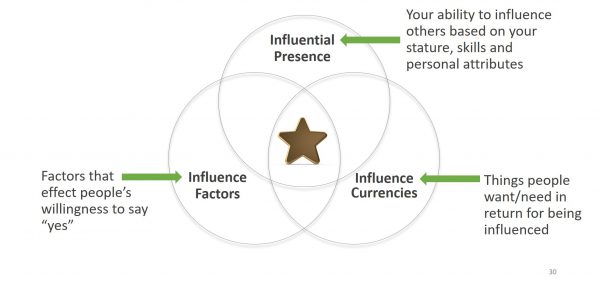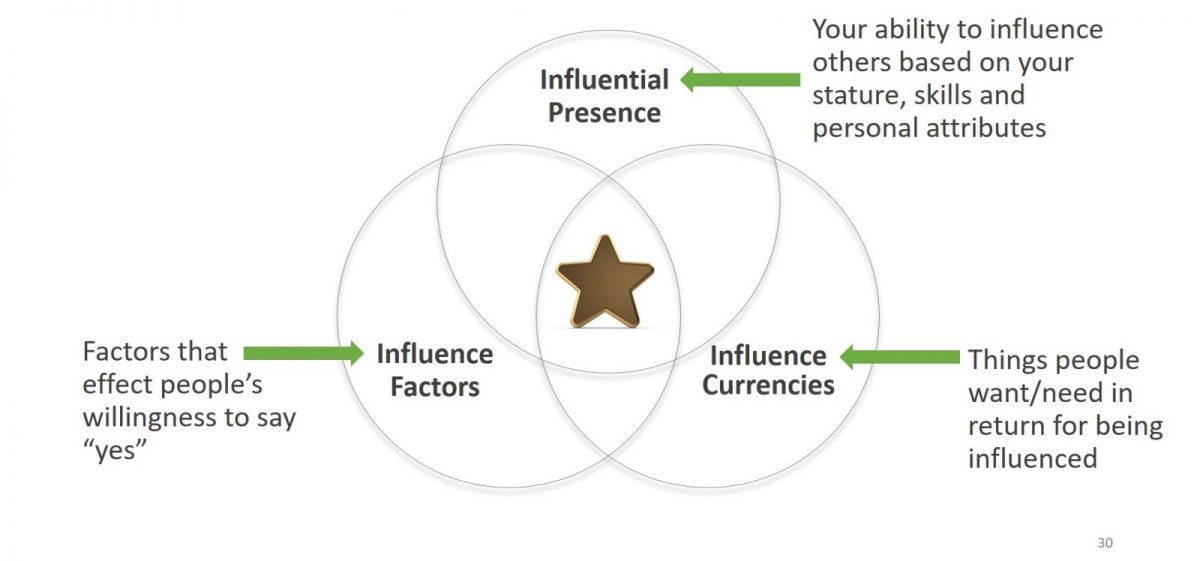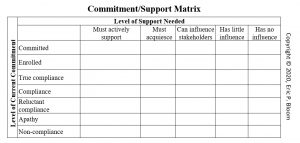Office influence is the ability to move a person’s thinking, actions, and/or decisions in a way that forwards your business objectives. As a result, it’s the tip of the spear in all workplace interpersonal communication activities, including negotiation, change, sales, leadership, conflict resolution and more. Negotiation is a highly interactive two-way type of influence. Sales are influencing customers to buy your products and services. The list goes on and on…
This type of influence provides different things to different people, based on their profession and organizational level. For CEOs, it means obtaining the needed support from investors, the board of directors, strategic partners and key customers. For those in the C-Suite, it means gelling as cohesive unit, while simultaneously jockeying for position, getting needed scarce resources, and meeting assigned organizational goals. For those below the C-Suite, increased influence means enhanced productivity, increased effectiveness, and accelerated upward mobility.
Examples from a profession-based perspective include, the clout that influence brings helps IT, HR and other internal organizational functions get a seat at the business strategy table. For Project Managers it means more easily gaining the needed support from their stakeholders and a higher level of prioritization and motivation from their dotted-line staff and other external resources.
Like most business endeavors, measurement is a key component of successful planning, implementation, and ongoing processing. This is also true in professional growth and influence enhancement. As said by Peter Drucker, “If you can’t measure it you can’t improve it.”
The Influence Power Rating (IPR) calculation allows you to conceptually measure your workplace influence from two key perspectives. The first is you as a person, based on your “Core Influence Characteristics.” The second is your “Situational Influence”, which is your relative level of knowledge and organizational power as compared to those you are trying to influence.
Your Core Influence Characteristics
Your core influence characteristics are five categories of personal and business attributes that can enhance or detract from your ability to influence others in the workplace. Understanding and enhancing these characteristics over time increases your overall influence potential. These categories are:
- Internal Personal Attributes: Who you are as a person
- External Personal Attributes: Your actions as observed by others
- Professional Stature: Your credentials, achievements, knowledge and experience
- Interpersonal Skills: Your ability to communicate with others
- Business Skills: Your ability at negotiating, running meetings, teambuilding, etc.
Situational Influence
In the workplace, as in life, all influence is situational. Understanding your relative level of knowledge and organizational control as compared to others, is key in assessing your ability to influence them. For example, a business owner has more influence-power over the employees than over the company’s customers. As another example, a brain surgeon who knows nothing about the NFL Football league has an incredibly high of influence over a patient, but no influence when discussing the best NFL quarterback with friends. However, if the discussion turns to the issue of concussion protocols in the NFL and other professional sports, the influence of this same brain surgeon skyrockets. The same is true in business between subject matter experts and corporate executives.
Influence Power Rating (IPR)
The Influence Power Rating (IPR) is a calculation that conceptually measures fifty-three personal and business attributes divided across the five categories previously discussed. A full description of each attributes in a blog not possible, therefore, I’ll explain the conceptual framework driving the calculation.

Figure 1: Influence Power Rating Calculation
When viewing this formula, you will see that that Core Influence Characteristics are additive. That is to say, that each of these items individually adds to your organizational clout, influential presence, and ability to professionally advance. The two situational items are your relative knowledge of the topic and organizational power as compared to the person or group you are trying to influence.
These last two items are multiplicative, meaning that in a specific conversation or presentation, they have the potential to magnify or totally negate your skills, abilities and background.
Understanding the crucial nature of these two situational factors can be used to help you properly prepare for virtually all one-one-one and group interactions. Going back to the CEO example, the CEO has significant organizational power over those in the C-Suite. Therefore, the CEO can overcome being poorly prepared for a C-Suite meeting by using her organizational power. Conversely, the C-Suite members in the same meeting must use their situational knowledge to influence the CEO.





